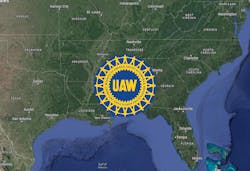Updated: UAW Supplier Organization Drive Generates Wins
Editor's note: This story originally ran on April 6, 2023. It has since been updated with recent news about UAW and union activity throughout the auto industry.
Latest: The UAW notched a supplier victory while trying to build steam in its organizing efforts at Mercedes, Toyota and other major automakers.
Workers at Antolin Interiors USA in Howell, Michigan, voted to unionize on January 30, 2024. The nearly 400 workers who make instrument and door panels for Ford, GM, Stellantis and PACCAR will join UAW Local 163, Region 1A.
Fresh off a closely divided union election, the UAW’s new leadership is more forthright than its predecessors in messaging about fighting for workers. But the shift from gas-powered to electric vehicles and a lack of union-organizing success in the South gives automakers their own leverage in September contract negotiations.
Excluding unionization efforts at Ford and General Motors in the 1970s, the UAW has overall been unsuccessful at organizing workers at plants in the South. Failed efforts include:
- 2023: A small number of Nissan Tennessee machinists in Tennessee voted down union representation in March.
- 2019: Volkswagen Tennessee workers vote down the union, 833 to 776.
- 2017: Nissan workers in Canton, Mississippi vote down joining the UAW, 2 to 1.
- Honda, its workforce centered in Southern Ohio and Indiana, has not had a vote to unionize since the 1980s. There have been several failed attempts at forming a UAW local.
- Toyota has been targeted for union organizing efforts several times, but hasn’t ever garnered enough support to take it to a vote.
Location of new electric-vehicle and battery-assembly plants matters for the UAW, as workers are reassigned and some existing plants either retooled or closed. It’s one bargaining chip automakers can use in negotiations, says Steve Silvia, a labor relations professor at American University and author of the new book The UAW’s Southern Gamble.
Another automaker tactic is withholding card-check union recognition—meaning that the automaker does not agree to stay neutral in any union organizing efforts. Card-check union recognition was on display recently at the GM/LG Ultium Cells LLC plant in Youngstown, Ohio, where 98% of workers voted to join the UAW, and GM leadership stayed neutral in the effort.
Suppliers Have Less Leverage
Suppliers are actually in a more vulnerable position than the OEMs in UAW negotiations going forward, says Robert Chiaravalli, a labor attorney who works with Tier 1 and 2 suppliers in union negotiations. Not only are their pockets less deep than the OEMs, “they’re not going to be in a position where they can take a strike, simply because the OEMS are not going to allow them to stop production.”
Union News Since April
Predictions that the UAW would target organizing automotive suppliers turned out to be prescient. Some developments since this story initially ran include:
- May 19, 2023: About 200 workers at Webasto Roof Systems join UAW Local 3000 near Detroit, Michigan. The workers make convertible tops for the Ford Musang and Bronco, Jeep SUVs and GM's Chevrolet Corvette.
- May 15, 2023: Workers at school bus maker Blue Bird in Fort Valley, Georgia, agree to join the United Steelworkers. The union argued that Blue Bird and other bus makers are due to a windfall from federal programs aimed at replacing diesel and gasoline buses with zero- or low-emissions models.
- May 8, 2023: UAW workers in Holland, Ohio, go on strike against battery maker Clarios. That strike is ongoing.
- On, April 13, IndustryWeek editors held a livestream conversation about the UAW and the impact changes in the union could have on the industry this year.
Chiaravalli recommends suppliers pay attention to and address worker dissatisfaction and give workers a voice before labor organizing starts at their facility. With suppliers dealing with a labor shortage that’s more protracted than the OEMs, employees at supplier facilities have been working long hours for a long time and are beyond burned out.
“When you have a satisfied workforce, they are less likely to strike and that means not only paying them what they consider a fair wage and benefit package, but it’s also are they treated properly and fairly,” says Chiaravalli. “But not every supplier has that reputation with their workers, and people have been worked really hard at suppliers. They have worked incredible loads of overtime. And they just need a break.
“Oftentimes in these negotiations, along with the wages and benefits is how do we get out of mandatory overtime. Or how do we get a little more break from a six- or seven-day work week.”
Why No Wins in the South?
Why have southern auto workers been consistently averse to unionizing, when their wages are lower and benefits fewer than at Ford, GM and Stellantis? Silvia sees several reasons. One is that even at plants where pay is much lower than union pay, it’s considerably higher than the going rate in the area for workers without a college education.
“The Nissan plant in Mississippi, you’ve got people who were getting minimum wage [at other jobs], says Silvia. “They work for the auto plant there, even if they’re getting paid, relatively less than people with a Big Three contract, they’ll start out at like $16 [per hour] and then move up to $20. That that's a lot better than $7.25.”
The specialized workforce training automakers like Toyota offer, in tandem with southern state workforce organizations, is also part of the appeal.
“I think another element is the selection of workers,” says Silvia. In the South, “companies go to some length, with interviews, to select workers, and a number of characteristics. The companies do look for people who they think are less likely to be interested in joining a union.”
It’s legal to ask, and automakers in the South do ask, whether someone has been in the military, or been active on sports teams in school, or even if they are the eldest child—all indicators that they are more likely to respect authority—the company—versus any union efforts.
“Another thing that’s very prominent is discussion of, ‘We’re one team.’” he says. “Almost all of the plants, that’s the language that they use. ‘We don't want to unionize because we’re one team and the ‘other team’ would be divisive.’
Video monitors in plant breaks rooms play messages “that are positive about the company and negative about the UAW,” says Silvia. “So, there’s definite psychological thinking about this, on how to communicate, to “educate” the workers.”
The fact that subsidies for new plants are particularly large in the South “is one more big piece,” says Silvia. “This has led the southern political establishment, which is almost exclusively Republican, to take the approach that ‘We didn’t pay $300 million, half a billion dollars to invite the UAW here to sponsor candidates to run against us.’ So they put a lot of pressure on the companies when it comes to unionization.”
That was particularly true with Volkswagen in Tennessee. Under pressure from its unions in Germany, the automaker gave the UAW unusually good access to its workers, allowing it to lobby for the union. Tennessee Governor Bill Lee personally encouraged workers to vote down the union, and Republican members of the state’s legislature threatened to withhold future economic development funds that the company would need to expand.
About the Author

Laura Putre
Senior Editor, IndustryWeek
As senior editor, Laura Putre works with IndustryWeek's editorial contributors and reports on leadership and the automotive industry as they relate to manufacturing. She joined IndustryWeek in 2015 as a staff writer covering workforce issues.
Prior to IndustryWeek, Laura reported on the healthcare industry and covered local news. She was the editor of the Chicago Journal and a staff writer for Cleveland Scene. Her national bylines include The Guardian, Slate, Pacific-Standard and The Root.
Laura was a National Press Foundation fellow in 2022.
Got a story idea? Reach out to Laura at [email protected]
